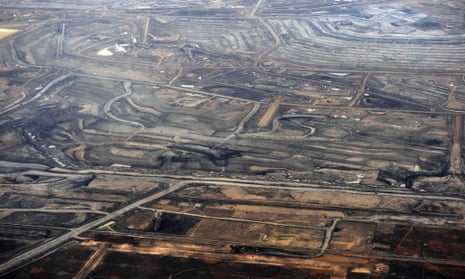This is like the movie Groundhog Day. I seem forever forced to correct the State Department’s errant analysis of Alberta tar sands emissions. Now, however, other people are agreeing with me. A recent paper published in Nature Climate Change reviewed the State Department’s accounting and found it deeply flawed.
The authors, Peter Erickson and Michael Lazarus of the Stockholm Institute included the impacts of Keystone on the global oil markets. This inclusion tripled the climate change impact of the Keystone pipeline compared to the State Department’s analysis. Let’s get into the study to see the reason for the change and also to understand why even this new analysis is flawed.
First, the State Department assesses the impact of tar sands by assuming it will merely displace, barrel for barrel, some other oil extracted somewhere else on the planet. Therefore, the State Department analysis only counts the incremental emissions for tar sands. Tar sands are approximately 17% worse in terms of emissions than other fuels (it depends on which fuel is the reference); the State Department only counts these extra emissions.
What the new study does is ask, how will the Keystone pipeline increase oil extraction globally? For instance, if oil prices decrease because of Keystone, then more oil will be extracted (up to 0.6 barrels more per barrel of tar sands). They reason, correctly, that an honest account must include the increased extraction.
In fact, this new accounting shows that the actual emissions are up to four times those proposed by the government analysis. To put some real numbers in, the authors report that Keystone would lead to up to 110 million tons of carbon dioxide equivalent per year.
The paper received a lot of well-deserved attention in the media both online at Think Progress and at Climate Central, by first-rate writer Seth Borenstein, and others. Of course, there was the quick (and ironic) complaint from Andrew Leach who is the Enbridge Professor of Energy Policy at the University of Alberta. The first irony is that Enbridge is a Canadian company that deals with tar sands and is fighting to expand its own pipelines. The second irony is that Andrew Leach argues we should consider the economic benefits of increased oil consumption at lower prices but is silent in his critique about the economic consequences of climate change.
But it is clear that even this new analysis is too low. Why do economists take an incremental approach to emissions? The true way to count the amount of carbon that the Keystone pipeline is responsible for is to count the amount of carbon that would flow through the pipeline when it is built. Another way of thinking about this is that we have three possible alternatives.
- Build Keystone and pump tar sands.
- Not build Keystone but extract the equivalent oil somewhere else.
- Not build Keystone and instead, use our energy more wisely, saving money and reducing pollution.
Now, economists like to compare prospect 1 to prospect 2. Instead, we should compare prospect 1 to prospect 3. I have made this argument in a court filing in Minnesota this year against the Enbridge pipeline, here in the Guardian, and elsewhere. With a caveat that we do not know the blend of mixture that would be pumped through Keystone; if it were all tar sands (or even mostly tar sands), the climate impact would be huge.
With the planned 830,000 barrels per days and emissions of 575 kilograms of carbon dioxide emissions per barrel (~ 625 when petcoke is included), the emissions associated with Keystone amount to about 480,000 tons of carbon dioxide per day (520,000 tons of CO2 per day with petcoke). This is, respectively, 170-190 million tons of carbon dioxide annually.
As a comparison, this carbon dioxide is equal to approximately 40 million cars or 55 coal plants. As an alternative, if the U.S. simply increased fuel efficiency 4 mpg, then we would save the entire stock of tar shipped through Keystone, we would reduce pollution, and each American would save approximately $250 per year. Of course, this solution is just too simple to work.

Comments (…)
Sign in or create your Guardian account to join the discussion